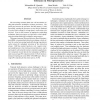119 search results - page 3 / 24 » Static Energy Reduction Techniques for Microprocessor Caches |
DATE
2004
IEEE
13 years 11 months ago
2004
IEEE
: Static energy dissipation in cache memories will constitute an increasingly larger portion of total microprocessor energy dissipation due to nanoscale technology characteristics ...
ICCD
2007
IEEE
14 years 1 months ago
2007
IEEE
Leakage power has grown significantly and is a major challenge in microprocessor design. Leakage is the dominant power component in second-level (L2) caches. This paper presents t...
VEE
2006
ACM
14 years 1 months ago
2006
ACM
During recent years, microprocessor energy consumption has been surging and efforts to reduce power and energy have received a lot of attention. At the same time, virtual executio...
MICRO
2000
IEEE
13 years 12 months ago
2000
IEEE
Dynamic Zero Compression reduces the energy required for cache accesses by only writing and reading a single bit for every zero-valued byte. This energy-conscious compression is i...
DSN
2005
IEEE
13 years 9 months ago
2005
IEEE
The increasing transient fault rate will necessitate onchip fault tolerance techniques in future processors. The speed gap between the processor and the memory is also increasing,...

